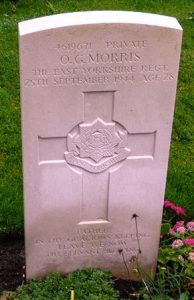Brynmawr is a market town situated in the historic county of Breconshire and is now part of Blaenau Gwent. The town is situated at the head of the South Wales Valleys and grew with the development of the local coal mining and iron industries in the early 19th century from its original settlement, which was named Gwaun Helygen, which sat on the border between the counties of Monmouthshire and Breconshire. The original village lay on the turnpike road from Abergavenny to Merthyr Tydfil and was surrounded with areas rich in coal deposits. With the development of Nantyglo ironworks, Gwaun Helygen was chosen as an ideal area for a settlement and houses sprang up rapidly to cope with the influx of workers. Whilst all of the men of Brynmawr who fell during both World Wars are commemorated on the main Brynmawr Cenotaph, there are also other memorials within the town, situated within some of the various places of worship there. This page of the website commemorates the five members of the congregation of the old Brynmawr Calvary Baptist Church who fell during the Great War of 1914-1918 and the three members who lost their lives during the Second World War of 1939-1945. The memorials used to be part of a war memorial organ, but the Chapel was later converted into a Buddhist Temple, and the memorial panels have been removed to Brynmawr Museum.
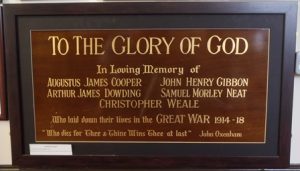
The Great War, 1914-1918
James Augustus Cooper, Private, 26016, Gloucestershire Regiment. James, known as Augustus, was born in 1893, the son of George Cooper and Annie Cooper (nee Thomas), of 140, King Street, Brynmawr. He worked as a coal hewer prior to enlisting at Brynmawr into the Gloucestershire Regiment in the summer of 1915. Augustus was drafted to France in the spring of 1916, joining the 8th Battalion, Gloucestershire Regiment. The battalion was in the Givenchy sector, attached to 57 Brigade, 19th (Western) Division. At the end of April 1916, the division was relieved and moved back into the 1st Army Training Area at Cresgues, before moving to Vignacourt, in the Somme rear area to begin an intensive training regime, in preparation to take part in the Somme offensive. On 27 June the division moved into support positions and watched the initial assault which began at 05.20 on 1 July 1916. On the following day the division moved forwards into the new front-line and took part in the second wave of the attack on Ovillers-La Boiselle. Augustus was killed in action during the fighting for the village on 3 July 1916. The 23-year-old has no known grave and is commemorated on the Thiepval Memorial, France.
Arthur James Dowding, Lance Corporal, 225665, Monmouthshire Regiment. Arthur was born in Abergavenny in 1887, the son of William Dowding and Emily Dowding (nee Thomas). The family had moved to 13, George Street, Brynmawr by 1893, and became members of Brynmawr Calvary Baptist Church. Arthur left home as a young man and joined the Post Office in 1907, becoming a postman in Newport. He enlisted at Blackwood into the 1/1st Battalion, Monmouthshire Regiment on 4 August 1914. The battalion mobilised at Stow Hill, Newport as part of the Welsh Border Brigade, Welsh Division before moving to Pembroke Dock. On 10 August 1914 the Division moved to Oswestry before moving to Northampton, then spent Christmas at Bury St. Edmunds before moving to Cambridge. In February 1915 the 1st Monmouth’s left the Welsh Division and embarked for France at Southampton on 14 February, disembarking at Le Havre the following day before entraining for Cassel and marched to billets at Dranoutre. The battalion then moved to Wulverghem and joined 84 Brigade, 5th Division before moving into the trenches for the first time. On 6 April, 84 Brigade moved to Locre to re-join the 28th Division before taking over positions at Frezenberg Ridge. On 22 April, just to the north, the Germans launched the first gas attack of the war upon French Colonial troops at Gravenstafel, heralding the opening of the Second Battle of Ypres. The fighting remained to the north of Polygon Wood until 3 May, when the Germans widened their attacks and the Polygon Wood sector was evacuated by the 28th Division, which fell back on the G.H.Q. line at Potijze. Over the coming days their new positions were shelled mercilessly, then on 8 May the Germans attacked. Despite heavy losses the Division held firm. The battalion had suffered such heavy losses that on 27 May it was merged with the 1/2nd and 1/3rd Monmouth’s in 84 Brigade. Arthur was shot in the shoulder whilst in the trenches at Vierstraat on 14 June 1915 and was treated at the 44th Field Ambulance before being sent to the 1st Canadian General Hospital at Wimereux. On 17 June he returned to England vis Hospital Ship and whilst on leave married Mildred Mary Way, of Cardiff. Arthur then embarked at Southampton for France again on 10 December 1915, re-joining the 1/1st Monmouth’s, which by then had become the Pioneer Battalion to the 46th (North Midland) Division. The division was sent to Egypt soon afterwards, embarking at Marseilles on 4 January 1916, but a month later embarked to Alexandria to return to the Western Front, moving to positions on the Somme. Here the Division took part in a diversionary Attack on the Gommecourt Salient on 1 July 1916, which was intended to draw attention away from the main attack on the Somme but suffered terrible casualties. The division then rested and refitted for several months at Arras, returning to the Somme at the end of 1916 to take part in Operations on the Ancre. During March 1917 the Division followed the German Retreat to the Hindenburg Line, and then fought in the Battle of Arras, taking part in the Battle of Hill 70. In 1918 the Division took part in the Advance in Flanders, and then moved south, where it was tasked with the breaking of the Hindenburg Line. The division fought at the Battle of the St Quentin Canal at the end of September, where its 137 Brigade completed one of the finest feats of arms in British military history, forcing the crossing of the St Quentin Canal at Riqueval on 29 September. With the mighty Hindenburg Line now breached, the Division continued its advance. The 1st Monmouth’s had moved into position on 2 October, in preparation to join the offensive and at dawn on 3 October 1918 launched an assault against the villages of Ramicourt and Montbrehain, as part of the Battle of the Beaurevoir Line. Arthur was killed in action during the assault that day. The 31-year-old has no known grave and is commemorated on the Vis-en-Artois Memorial, Haucourt, France. Arthur is commemorated on the Brynmawr Calvary Baptist Church Memorial but not on the Brynmawr Cenotaph.
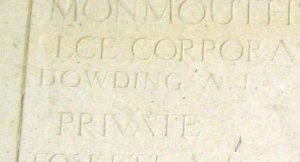
John Henry Gibbon, Driver, 161255, Royal Engineers. John was born in 1892, the son of John Gibbon and Ruth Gibbon (nee Jones), of 151, king Street, Brynmawr. He married Amy Elizabeth Powell on 31 January 1914 and the couple set up home at 4, Queen Square, Brynmawr. John worked as an assurance agent prior to enlisting at Newport into the Royal Engineers on 29 November 1915 and was posted to the Depot at Chatham for training. John then embarked at Southampton on 27 April 1917, disembarking at Alexandria on 23 May and was initially posted from the Depot at Alexandria to the 3rd Signal Squadron, Royal Engineers. On 3 October 1918 John was posted to the 4th Cavalry Division Signal Squadron, but within days he became ill and was sent to the 17th General Hospital at Alexandria. John died there of malaria on 17 October 1918. The 26-year-old is buried in Alexandria (Hadra) War Memorial Cemetery, Egypt.
Samuel Morley Neat, Private, 29616, Royal Welsh Fusiliers. Samuel was born on 24 September 1896, the son of James Frank Neat and Elizabeth Margaret neat (nee Hope), of 70, King Street, Brynmawr. He won a scholarship at the Brynmawr County School, and, subsequently went to the Normal College, at Bangor, before gaining a position as a teacher Nantyglo Council School. Samuel enlisted at Bangor into the Royal Welsh Fusiliers on 21 January 1916 and was posted to the 21st Battalion, Royal Welsh Fusiliers at Kinmel Park for training. Samuel was drafted to France that summer, embarking at Folkestone aboard the SS Henrietta on 24 June 1916 and disembarked at Boulogne on the following day, before joining the 38th Infantry base Depot at Étaples. On 9 July 1916 he was posted to the 1st Battalion, Royal Welsh Fusiliers, which was on the Somme, attached to 22 Brigade, 7th Division. The Division had taken part in the opening assault of the Somme offensive on 1 July 1916, advancing from positions near Bois Francais, near Fricourt, and capturing the village of Mametz, one of the few successes of 1 July 1916. The battalion then took part in further attacks to push forwards, to the south of Mametz Wood, and upon being relieved, witnessed the troops of the 38th (Welsh) Division moving forward to launch its assault on Mametz Wood. On 14 July, with the wood taken, the 7th Division moved back into the line, with orders to capture Bazentin-le-Petit, before taking part in the terrible attacks on High Wood over the coming days. On 22 July the 1st RWF was relieved, moving back into reserve to rest and rebuild at La Chaussee. By 12 August the battalion had moved forwards to Dernancourt, and on 26 August marched further forward, to take part in the Divisions assault on Ginchy. The Division saw heavy fighting over the coming days, before the 1st RWF had another short break, but on 1 September the battalion received orders to push forwards again to launch a fresh assault on Ginchy from Montauban Alley. On 3 September 1916 the 1st RWF launched its assault, but suffered severe casualties, with over 200 officers and men killed, wounded or missing. Samuel was killed in action during the fighting that day. The 19-year-old has no known grave and is commemorated on the Thiepval Memorial, France.
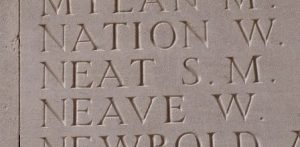
Christopher James Weale, Private, 26582, South Wales Borderers. Christopher was born in 1893, the son of Christopher Weale and Elizabeth Weale (nee Gregory), of 7, George Street, Brynmawr. He left Brynmawr to become a Drapers assistant at Newport as a young man, then set up his own Drapery at Ebbw Vale prior to the war. Christopher enlisted at Ebbw Vale into the South Wales Borderers in the spring of 1915 and was drafted to Egypt early in 1916, joining the 4th Battalion, South Wales Borderers, which was attached to 40 Brigade, 13th (Western) Division. The division had been evacuated from Gallipoli to Mudros on 8 January 1916 before moving to Egypt, then on 15 February 1916 embarked at Suez, arriving at Basra on 4 March to join the forces being assembled to attempt to relieve the besieged garrison of Kut-al-Amara. Unfortunately, the relief failed, and Kut fell to the Turks. The Division then took part in the advance through Mesopotamia, which was to successfully liberate the country from 100’s of years of Ottoman rule. By 28 May 1918, Divisional HQ had moved to Dawalib, and it remained here until the end of the war, with many working parties being supplied for work on maintaining roads. On 18 October the 4th SWB left Kifri and began a march north towards Kirkuk, together with two artillery batteries and the 40th Brigade Machine Gun Corps. The column, known as Lewins Column, continued its march over the coming days in hard conditions and on 24 October 1918 the column came in contact with the enemy, who opened up an artillery barrage upon it. Christopher was killed during this advance to Kirkuk on 24 October 1918, the sole man killed that day. The 25-year-old has no known grave and is commemorated on the Basra Memorial, Iraq.
World War Two, 1939-1945
Francis Parry James, Driver, T/3911936, Royal Army Service Corps. Francis was born on 20 January 1920, the son of David William James and Margaret James (nee Edwards), of 100, Worcester Street, Brynmawr. He enlisted into the Royal Army Service Corps, before being attached to the 48th Light Anti-Aircraft Regiment, Royal Artillery. The regiment was equipped with three batteries, armed with Bofors guns and sailed from Gourock on the river Clyde the day Japan declared war, 7 December 1941 aboard the SS Duchess of Athol. The ship, sailing in convoy, stopped at Freetown, then on to Durban where the regiment trans-shipped aboard the HMT Dunera, originally destined for Singapore, but with the garrison under heavy attack, the convoy was diverted to Batavia, Java, and docked at Tanjong Priok harbour. The three batteries then disembarked and set up around airfields on the island where they soon came under attack by Japanese aircraft. The Japanese then invaded Java on 28 February 1942 and after a brief but ferocious fight, the island fell on 12 March. Francis and the survivors of his regiment were then marched into captivity at Boei Glodak Jail. He was later transferred to another camp at Kuching where he remained for almost three years. Francis died of a tropical ulcer at Kuching on 11 May 1945. The 25-year-old was originally buried in Lintang Cemetery, Kuching, but the war graves from the cemetery were exhumed in November 1947 and re-interred in Labuan War Cemetery, Malaysia.
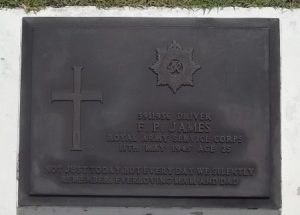
Stanley James, Private, 4034013, King’s Shropshire Light Infantry. Stanley was born in 1919, the son of Alfred James and Margaret James (nee Bevan), of 290, King Street, Brynmawr. His father was originally from the small village of Nevern, in Pembrokeshire. Stanley enlisted into the army and was posted to the 2nd Battalion, King’s Shropshire Light Infantry. The battalion had begun the war in Jamaica, with a company detached to the Bermuda Garrison, before returning to Britain to join the 185th Infantry Brigade, 79th Armoured Division. The brigade then transferred to the 3rd Infantry Division in April 1943; however, it was replaced by the 1st Canadian Infantry Division. The 185th Brigade then took part in the D-Day landings of 6 June 1944, landing at Sword Beach, and joined the great fight to break out of the beaches before heading for Caen. The brigade initially failed to capture Caen due to the presence of the 21st Panzer Division, but gallantly fought in the successful Operation Goodwood, which saw Caen fall. Stanley was killed during Operation Goodwood on 18 July 1944. The 25-year-old was buried in Ranville War Cemetery, France.
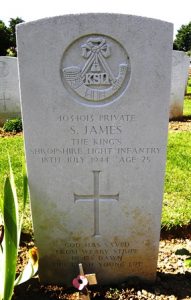
Owen Glyn Morris, Private, 4619671, East Yorkshire Regiment. Owen was born in 1916, the son of Tudor John Morris and Jennet Maggie Morris (nee Williams), of 10, Windsor Road, Brynmawr. He enlisted into the army and was posted to the 5th Battalion, East Yorkshire Regiment. The battalion was attached to the 69th Infantry Brigade, 23rd (Northumbrian) Division and had been in France with the BEF in 1940, before being evacuated from Dunkirk. Upon its return to England, the 5th East Yorks transferred to the 50th (Northumbrian) Division and embarked for North Africa, serving through the Western Desert, Tunisian and Sicily campaigns before being recalled to Britain to prepare for the invasion of occupied Europe. The battalion landed with the division among the first wave on Gold Beach on D-Day, 6 June 1944, taking part in the heavy fighting to break out from the Normandy Beaches. The division then fought in the Battle for Caen, before breaking out of Normandy and joined the great drive through Northern France into Belgium and Holland over the coming weeks. The division then took part in Operation Market Garden, Montgomery’s audacious plan to seize the Rhine crossings in an attempt to shorten the war. The operation was launched on 17 September 1943 and the division joined the great advance towards Arnhem over the coming days, seeing heavy fighting at Valkenswaard and Nijmegen. Owen was killed during heavy fighting around Bemmel on 25 September 1944. The 28-year-old was originally buried in a temporary battlefield cemetery near Lent, but in September 1945 all of the graves were exhumed and re-interred in Arnhem Oosterbeek War Cemetery, Netherlands.
